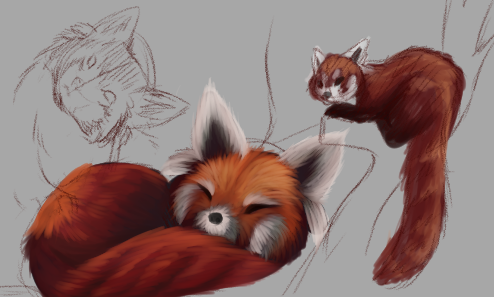JUNGLE EXPEDITION: RED PANDA REPORT
Red panda (Ailurus Fulgens) also known as the lesser panda, fire cat or firefox, lives in the Eastern Himalayas and southwestern china. The red panda closest relative is the Mephitidae(skunks) being under the Mustelidae family along with mustelidae (weasels, otters, badgers, wolverines) Procyonidae (racoons, Coati, ringtail). They can grow up to 51-63.5 cm in head-to-body length with a 28-48.5 cm tail. Males tend to be slightly bigger compared to females. Red panda’s also weigh about 3.2 and 15 kg or 7.1 and 33.1 Ib.
Red panda’s are known for having a Coat of mainly red or orange brown with a black belly and legs. The muzzle, cheeks, brows and inner ears marins are mostly white while the long bushy tail has alternating rings of red and buff with a dark brown tip. The coloration helps them blend in with the red moss that grows on the Lichen-covered trees. The fur consists of coarse guard hairs with a soft dense, wooly undercoat. They have Moderately long whiskers around their mouth, lower jaw and chin. They also have hair on the soles of their paws to allow them to walk on the snow.the front paws possess a False thumb which is an Extension of the wrist bone which gives the remarkable flexibility
Red Pandas are adapted climbers due to flexible joints and curved semi-retractile claws. Their specialized wrists allow them excellent grim and the ability to climb down trees head first as well as hold onto branches and food such as bamboo. There are only two currently recognized Red panda’s, the Himalayan and the Chinese red panda that genetically diverged around 250,000 years ago. 25 to 18 million years ago fossil records also indicated Extinct relatives in Eurasia and North america.
Red panda's inhabit Nepal, Bhutan, India, Myanmar and china. living in temperate climate around 2,000 to 4,300 meters or 6,600 to 14,100 feet) in elevations. Within Nepal, there are six Protected areas for the red panda all within the Eastern himalayan Broadleaf forests Ecoregion. Red Pandas are normally Arboreal meaning they mainly live in the trees.
Red Panda are omnivorous meaning they can eat plants, animals, fruit and insects, but their diet is mostly made up of bamboo with the occasional fruit, insect, birds, eggs, and small mammals. normally eating the young leaves of the bamboo as well as bamboo shoots, where the great panda eats the stock of the bamboo allowing the two animals to co-exist.
The largest threat is from humans throwing the population, deforestation, and disturbances by herders and livestock. The trampling of livestock depressed the growth of bamboo as well as clear-cutting which decreases the ability of some bamboo species to regenerate. One of the main issues was caused back in the Victorian age where people sought them out to become pets. pulling them from their natural habitat.
There are currently Community-based Conservation programs in Nepal, Bhutan and North India while in China they have Nature Conservation projects. Currently to help the numbers they are working on captive breeding in zoos.
References:
https://en.wikipedia.org/wiki/Red_panda
https://www.youtube.com/watch?v=ygA-XtGHVOU
Submitted By Solarus
for Jungle Expedition: Report
・ View Favorites
Submitted: 3 years ago ・
Last Updated: 3 years ago
